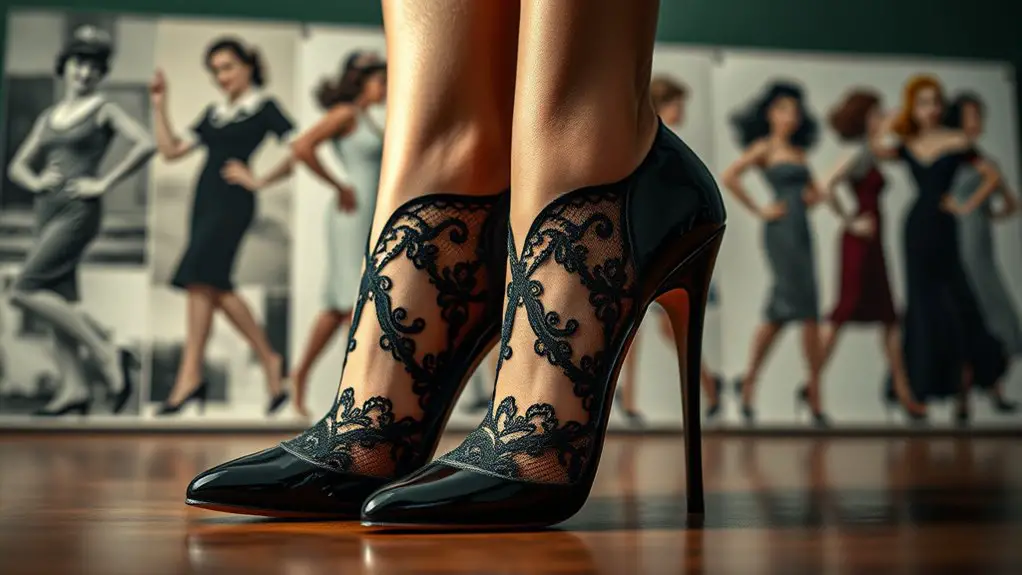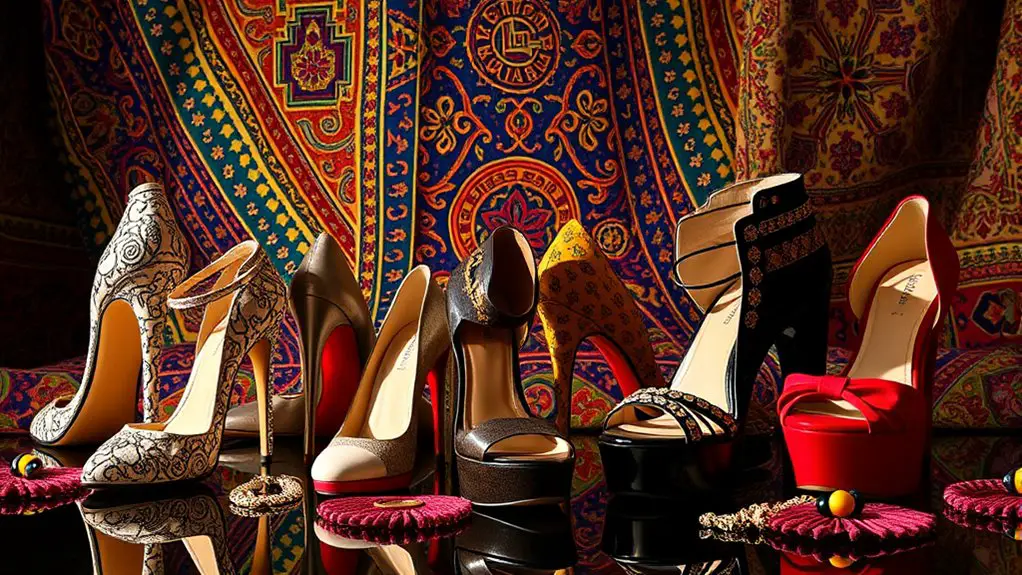Heels have evolved into powerful symbols of feminine identity, blending empowerment with societal expectations. Initially worn by men, they shifted to women’s fashion as a representation of allure and status. When you wear heels, you might feel more confident, as they can enhance your posture and project authority. This duality highlights the tension between personal expression and conformity to beauty standards. Explore how this fascinating relationship between heels and empowerment transcends mere footwear.
The Historical Evolution of High Heels

Although high heels are often associated with modern femininity, their origins trace back centuries, revealing a complex interplay of social status and gender norms. Initially, high heels were worn by men in the 15th century, symbolizing power and elite status. As fashion evolved, these shoes changed into women’s wardrobes, influenced by societal standards that dictated femininity and allure. The rise of the stiletto in the 20th century marked a significant shift, as its design emphasized both elegance and sexuality, further embedding high heels into the narrative of women’s fashion.
This evolution illustrates how societal influence can shape perceptions of power and femininity. High heels became a tool, allowing women to navigate social spaces historically dominated by men. Consequently, their journey reflects broader trends in fashion evolution, where shoes not only serve a practical purpose but also act as statements of identity and status, continually redefining what it means to be powerful.
High Heels in the Context of Gender Norms
As society’s expectations of femininity have evolved, high heels have become a contentious symbol of gender norms, often illustrating the tension between empowerment and objectification. While some view heels as a tool for asserting confidence and authority, others argue they reinforce restrictive gender expectations. You might find that social perceptions of high heels vary notably, influencing how women navigate professional and social spaces.
For many, wearing heels can be a conscious choice, an expression of personal style or power. Yet, it can also evoke the pressure to conform to ideals that prioritize appearance over comfort or functionality. This duality highlights the complexities of gender norms; heels can empower one moment and constrain the next. Ultimately, your relationship with high heels reflects broader societal messages about femininity, challenging you to reflect on how fashion choices intersect with personal identity and societal expectations.
The Psychological Impact of Wearing Heels

Confidence often swells with the click of a heel on the pavement, as many women report feeling a surge of empowerment when they don their favorite pairs. This phenomenon is rooted in the psychological benefits associated with heel symbolism, where the act of wearing heels transcends mere fashion.
The sound of heels can ignite a powerful sense of confidence and empowerment in women, elevating both stature and spirit.
- Increased Perceived Authority: Heels can elevate your stature, both physically and socially, leading to perceptions of dominance.
- Enhanced Body Language: Wearing heels often encourages an upright posture, which can project confidence and assertiveness.
- Personal Identity Expression: The choice of heels allows you to express individuality, reinforcing a sense of self-worth.
These psychological impacts reveal how heels serve as more than just footwear; they become a tool for women to navigate societal expectations and embrace their strength, merging style with psychological empowerment.
Heels as a Tool for Empowerment in Professional Settings
When you slip on a pair of heels for work, you’re not just changing your footwear; you’re actively enhancing your professional image and boosting your confidence. The right heels can transform how you carry yourself, influencing both your demeanor and the perceptions of those around you. In a competitive environment, this subtle shift can serve as a powerful tool for asserting your presence and authority.
Confidence Boosting Footwear
Empowerment often manifests in the choices we make about how we present ourselves, and for many women, heels serve as a powerful tool in the professional arena. The right pair of heels can greatly enhance your confidence, transforming not just your posture but also your presence in meetings or presentations. Here are three ways heels contribute to confidence enhancement in professional settings:
- Posture Improvement: Heels encourage an upright stance, conveying authority and confidence.
- Heel Trends: Staying updated with current styles can signal professionalism and adaptability in your field.
- Psychological Boost: The very act of wearing heels often instills a sense of empowerment and readiness to tackle challenges.
In this way, heels become more than mere footwear; they embody a statement of professional self-assurance.
Professional Image Enhancement
Heels can considerably shape your professional image, serving as a subtle yet impactful tool for empowerment in the workplace. When you think about professional attire, your footwear choices play an essential role in how others perceive you. Heels elevate not just your height but also your overall presence, projecting confidence and authority. In many corporate environments, they complement tailored outfits, signaling professionalism and attention to detail. The right pair can enhance your posture and convey a sense of poise, allowing you to navigate meetings and presentations with greater assertiveness. Ultimately, integrating heels into your professional wardrobe can be a strategic move, aligning your appearance with your ambitions and the dynamics of the workplace.
Cultural Variations in the Perception of Heels

When you consider heels, it’s essential to recognize how their significance shifts across cultures. In some places, they’re a bold statement of femininity and empowerment, while in others, they might symbolize status or tradition. Understanding these cultural variations not only enriches your perspective on fashion but also highlights the complex history and symbolism tied to heels globally.
Global Fashion Trends
While many view heels as a universal symbol of femininity, their cultural significance varies widely across the globe. This diversity reflects the intricate interplay of global fashion and regional styles, shaped by cultural influences and market dynamics. Consider these variations:
- Design Variations: In Italy, heels often feature elaborate craftsmanship, showcasing artistic flair, while in Japan, minimalistic styles emphasize subtlety.
- Celebrity Endorsements: In the U.S., celebrities amplify trends through social media, influencing consumer preferences rapidly.
- Fashion Cycles: Different regions experience unique fashion cycles; for instance, high-heeled sandals may dominate summer looks in Brazil but be less favored in colder climates.
Understanding these differences illuminates how trend evolution isn’t just about aesthetics but also about cultural narratives that shape perceptions of power and femininity.
Historical Contexts and Symbols
Despite their contemporary association with femininity and empowerment, heels have a complex history that varies across cultures. In ancient Persia, men wore heels to signify status, while in 16th-century Europe, heels became feminine symbols tied to societal expectations of beauty and grace. In some cultures, high heels were seen as tools of seduction, enhancing women’s allure and power over men. However, this allure also came with constraints, reinforcing traditional gender roles. In contrast, some cultures embraced flat shoes as symbols of practicality and strength. Today, as you navigate the fashion landscape, it’s essential to recognize that the perception of heels is deeply rooted in historical contexts, reflecting changing values and the ongoing tension between empowerment and societal norms.
The Relationship Between Heels and Self-Expression
Although heels have long been associated with femininity and elegance, their role as a medium for self-expression transcends mere aesthetics. For you, heels can symbolize aspects of your personal identity, allowing you to convey your unique self-expression styles. Consider how the choice of heels can reflect your mood, aspirations, or even defiance against conventional norms.
- Color & Design: Bold colors or intricate designs can showcase your personality, acting as a visual representation of your individuality.
- Height & Style: The height and style you choose can signal confidence and assertiveness, making a statement about how you perceive yourself in various spaces.
- Occasion: Different heels for different occasions reflect adaptability, allowing you to express multifaceted aspects of your identity.
Ultimately, heels are more than footwear; they’re a powerful tool for articulating who you are in a world that often seeks to define you.
Challenging Beauty Standards Through Heel Fashion
As you navigate the complexities of contemporary beauty standards, heel fashion emerges as a potent means of resistance and redefinition. By donning heels, you’re not just adhering to societal expectations but actively challenging them. This footwear choice can serve as a bold statement of feminine identity, allowing you to reclaim your narrative in a world often dominated by rigid definitions of beauty.
Heels can empower you to rewrite the script, pushing against the confines of traditional femininity. Rather than merely conforming to external standards, you embrace a personal aesthetic that reflects your individuality. This choice embodies a powerful counter-narrative, subverting the idea that beauty must be uncomfortable or painful.
In doing so, you redefine what it means to be feminine, illustrating that power and grace can coexist. Ultimately, heel fashion allows you to assert your identity while defying the limitations imposed by society, turning footwear into a form of self-expression.
Icons of Feminine Power: Celebrities Who Embrace Heels
In the domain of fashion, heels have become a quintessential emblem of feminine power, and many celebrities have embraced this footwear as a statement of their identity and influence. Their choices often reflect a broader cultural narrative, showcasing how celebrity influence can drive a style evolution that empowers women.
Consider these three icons who embody this phenomenon:
- Beyoncé – With her towering stilettos, she commands the stage and symbolizes strength and independence.
- Lady Gaga – Known for her avant-garde style, her heels challenge norms, illustrating that power can manifest in unexpected ways.
- Michelle Obama – Her chic heel choices during public appearances emphasize confidence and grace, advocating for women’s empowerment.
These celebrities not only elevate their own style but also inspire countless others, reinforcing the notion that heels are more than just footwear; they’re a powerful symbol of feminine identity and influence in today’s society.
Frequently Asked Questions
Do Men Ever Wear Heels as a Power Statement?
Imagine a peacock strutting, feathers fanned wide. Men can indeed wear heels, challenging gender norms and embracing fashion rebellion, creating a bold statement that defies traditional expectations—proclaiming confidence and individuality in a world often rigid.
How Do Different Heel Heights Affect Perception of Power?
Heel height substantially influences power perception; higher heels often convey authority and confidence, while lower ones may suggest approachability. You’ll notice how varying heights alter both your stance and the way others perceive your presence.
Are There Specific Heel Styles Associated With Empowerment?
When you slip into a stiletto, it’s like donning armor; stiletto symbolism conveys confidence, while platform psychology suggests stability. Both styles empower you, transforming perception and enhancing presence in any setting, amplifying your voice.
What Are the Health Impacts of Wearing High Heels Regularly?
Wearing high heels regularly can considerably impact your foot health and ankle stability. You might experience discomfort, increased risk of injuries, or long-term issues like plantar fasciitis, as your feet struggle to adapt to unnatural positions.
Can Heels Influence Social Dynamics in Non-Professional Settings?
In social dynamics, heels can shift perceptions akin to the allure of Sirens, affecting cultural symbolism. They often create an impression of confidence and femininity, influencing how others perceive and interact with you in non-professional settings.



